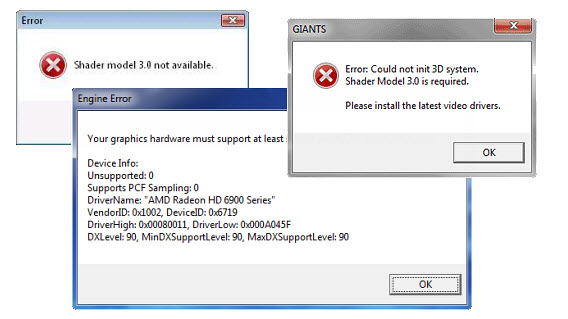

- How to fix shader model 3.0 error how to#
- How to fix shader model 3.0 error install#
- How to fix shader model 3.0 error driver#
Processor: Intel(R) Atom(TM) CPU N450 1.66GHz (2 CPUs), ~1.7GHzĬard name: Intel(R) Graphics Media Accelerator 3150Ĭhip type: Intel(R) Graphics Media Accelerator 3150 System Manufacturer: ASUSTeK Computer INC. Language: Italian (Regional Setting: Italian)
How to fix shader model 3.0 error install#
Populating this database generally requires trial-and-error and a lot of different hardware configurations, so can be difficult for the lone developer to do, unfortunately.Operating System: Windows 7 Professional 32-bit (6.1, Build 7601) Service Pack 1 (7601.win7sp1_gdr.130828-1532) If that error appears your computer must be literally a toaster (The GPU is almost 10 years old and an onboard chip). Posts: 22662 Joined: Status: offline something must be wrong with the drivers, as the card supports Shader Model 5.0 on the API front, so backwards 3.0 shouldn't be an issue but it is, so either go back to the previous drivers, or don't load the tools which sometimes come with them, MSI ones are known to cause issues with some games and widows etc, so a clean install of drivers only.
How to fix shader model 3.0 error how to#
What I have done to account for that kind of issue in the past is build up a locally-maintained "feature database" API that allows me to store information about particular card/driver failures and how to fall back to safe alternative code paths when that hardware/driver combination is present on the end-user's machine. although this will not catch all bugs/failures.
How to fix shader model 3.0 error driver#
This is much rarer these days than it used to be, but in these cases you can't really trust the hardware or driver anyhow and will have to "do it yourself." One way to do this is to simply try to create something using SM3 and see if it fails. This is because, as you alluded to, it's possible for cards to lie or for there to be driver bugs that effectively render particular hardware/driver combinations "non functional" (or at least broken in a fashion you'd want to work around). if there is no log.txt created, then you could run DxDiag (DirectX diagnostics tool), then save the results to a text file, then copy and paste what's in it to a reply. You'll note that I said "should be guaranteed" in a few places. and see if there is a log.txt created, which you can open with notepad and copy and paste what's in it to a reply. Below the 10_0 level you have some odd 10Level9 differences to take into account - the upshot for you is that you have to use odd shader model designations like vs_4_0_level_9_1 in some (perhaps all, we're getting into territory I haven't explored much in practice) scenarios. If you're using the 10_0 feature level or greater, you should be guaranteed SM4. For D3D11 (which I'd recommend over 10, since it should be the case that you can use 11 if you can use 10) device capabilities are categorized into feature levels. All four are described on the linked documentation page.įor D3D10 you should be guaranteed SM4. Of interest to you concerning this problem will the fields in the resulting structure called VertexShaderVersion and PixelShaderVersion as well as possibly MaxVertexShader30InstructionSlots and MaxPixelShader30InstructionSlots.

This will give you a structure containing a lot of interesting information about what the hardware supports. If you are using D3D9, you can query for device capabilities reported by your card using the IDirect3D9::GetDeviceCaps method.


 0 kommentar(er)
0 kommentar(er)
